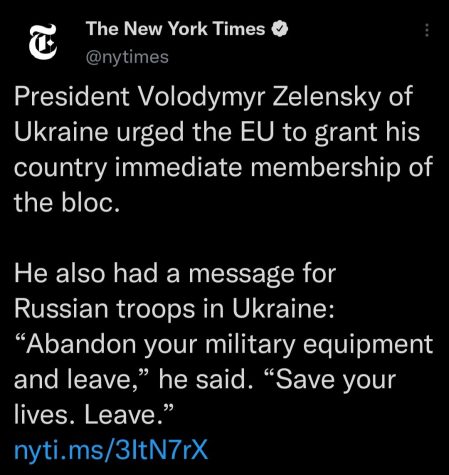Ukraine and Russia Conflict: Updates
Fri. 26, 2022
A full scale invasion of Ukraine has begun as of the night of Wednesday, Feb. 23. Russian President Vladimir Putin announced a military operation in Ukraine.
According to CNN, teams placed in Kyiv have heard multiple explosions near the capital ever since the announcement.
However, the Russian military later put out a statement “The Russian Armed Forces are not launching any missile or artillery strikes on the cities of Ukraine. High-precision weapons destroy military infrastructure: military airfields, aviation, air defense facilities of the Armed Forces of Ukraine. The civilian population is not at risk.”
CNN also wrote that they heard air sirens sounding for several minutes in Kyiv around 7 a.m. local time (12am ET/9pm PST).
The United States is getting involved within the conflict, according to President Joe Biden on Twitter.
“Russia alone is responsible for the death and destruction this attack will bring, and the United States and its Allies and partners will respond in a united and decisive way,” U.S. President Joe Biden tweeted on Wednesday, “The world will hold Russia accountable.”
Mon. 28, 2022
Ukraine agrees to sit down with Russia over negotiations for a ceasefire five days after Russia launches an all-out assault.
While the talks may spark hope towards ending the conflict, many Ukrainian officials are skeptical that the discussions will lead anywhere.
On the other hand, Ukrainian President Zelensky has applied for membership into the European Union. Zelensky asks that the EU immediately allow the admission of Ukraine under “a new special procedure”. Moreover, this move would be a significant loss to Vladimir Putin as the tension erupted over Putin’s unwillingness to let Ukraine join NATO. In addition, admission into the EU could potentially end talks of a ceasefire between the nations.

The EU has also decided to help Ukrainian forces by sending military equipment.
The Week reports that EU foreign policy chief Josep Borrell said in a statement that the EU intends to spend $500 million in military equipment to Ukraine, including fighter jets and another $55 million in non-lethal support.
In addition, the US and allies have imposed sanctions against Russian leaders and cut Russian banks from the global banking system. According to an AP report, “…The central bank restrictions target access to the more than $600 billion in reserves that the Kremlin has at their disposal.”
Inside of Russia, the effects of the harsh economic sanctions are already being seen, with massive inflation and bank runs. As a result, Russian banks have increased interest rates, and the rouble’s value has diminished harshly.
According to a report from Reuters: “Western sanctions had earlier sent the rouble tumbling nearly 30% to record lows. It clawed back some ground after the central bank raised its main interest rate to 20%, the highest level this century, from 9.5%.”
Following action from the EU, the Russian president Vladamir Putin announced that he is putting nuclear forces on high alert. The AP says, “Putin issued a directive to increase the readiness of Russia’s nuclear weapons, raising fears that the invasion of Ukraine could lead to nuclear war, whether by design or mistake.”
“This is really a pattern that we’ve seen from President Putin through the course of this conflict,” White House Press Secretary Jen Psaki replied when asked about Russia’s move to ready nuclear powers, “which is manufacturing threats that don’t exist in order to justify further aggression — and the global community and the American people should look at it through that prism,”
The original version of this story was written by Ashley Cortez. This is a developing story, and there will be more updates at a later time.







